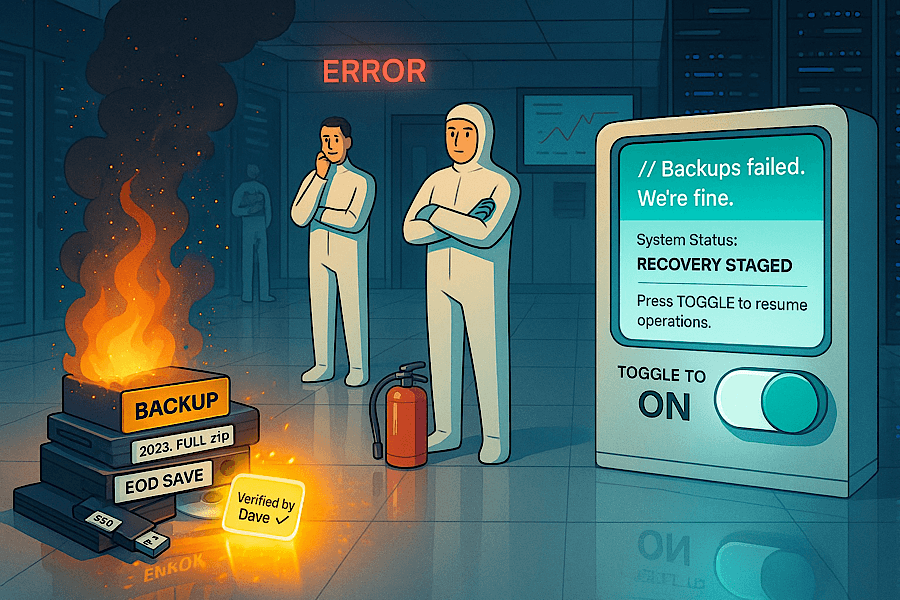Backups Are Not a Strategy

“The Limits of Traditional Backup Thinking. Backups are easy. Recovery is where things get complicated.” Illustrated by ChatGPT & DALL·E
(But toggling the business back on might be)
A Cloud Field Day 23 perspective on what’s really at stake when systems fail—and what Commvault thinks we can do about it.
Most executives assume the business will recover.
It’s an optimistic belief—generous, even. And not entirely unfounded. There are backups. Someone signed off on a disaster recovery plan. There’s probably a PDF of the incident response flowchart buried in a Confluence space no one’s opened since the last tabletop exercise.
But what if those backups aren’t clean?
What if the application configuration didn’t survive the failover?
What if no one’s tested recovery since remote work became the norm—or since the last time the auditor asked?
I remember leading a recovery test at a major superannuation firm in Australia. On paper, everything looked sound—there were backups, plans, approvals. But the moment we tried to restore, we ran into friction: configuration drift and gaps in sequencing that no one had clocked during setup.
It wasn’t a crisis, but it wasn’t clean either. And that’s the uncomfortable truth most organisations live with, you don’t really know what’s missing until the moment you need everything to work.
These are the questions Commvault surfaced at Cloud Field Day 23—not as scare tactics, but as overdue reality checks. Resilience, they suggested, shouldn’t be assumed—it must be demonstrable.
🔎 Seeing Is Surviving
The opening message was quiet but clear: The first step to recovery isn’t technology—it’s knowing what you’re recovering.
Commvault put it plainly—most enterprises don’t know where their data is, or whether it can be trusted. This isn’t a failing of effort. It’s the side effect of modern complexity: sprawling environments, fuzzy ownership, and policies written in legalese.
To navigate this, Commvault is building for visibility:
- A unified telemetry layer to spot anomalies before they spread
- Tools to validate whether backup data is actually usable
- Policy mapping that clarifies what’s protected—and what’s not
It’s not just about protection. It’s about knowing what you have, where it is, and how fast you can get it back.
🛡️ Cloud Rewind and the business case for Recovery-as-Code
Once you’ve seen the gaps, what do you do about them?
Enter Cloud Rewind (formerly Appranix), Commvault’s approach to transforming recovery from an awkward ritual into an automated muscle .
Think Terraform, but for your recovery stack. If an incident hits, you don’t rebuild by memory. You can rebuild infrastructure, configurations, and policies to a previously validated state—across regions and accounts. “You can turn it on like an iPhone toggle” was how it was described by the Commvault team.
This is recovery as a service—and a mindset.
Less panic. More preparedness. Less whiteboard, more workflow.
⚙️ Under the Hood: Cloud Rewind’s Architecture in Practice
Cloud Rewind automates rollback using recovery groups and known-good configurations, enabling teams to restore infrastructure and application states across regions and accounts without manual reconstruction.
Behind the scenes, Commvault outlined how the platform supports:
- Clean-room recovery: spinning up isolated environments to validate restorability before cutting over to production
- Forensic flexibility: integrating scanning tools to examine the recovered environment for threats—without slowing down response
- Policy-aligned orchestration: reducing complexity while ensuring the right telemetry and recovery options surface when they matter most
It’s a shift from reactive response to repeatable readiness—with automation and transparency at its core.
🌩️ Clumio and the case for Default-Resilience
For AWS-native workloads, Clumio offers a different kind of comfort.
Acquired by Commvault and built for hands-off operation, it protects S3, DynamoDB, and more—with:
- Immutable, air-gapped backups
- Zero infrastructure management
- Users who “log in once every 37 days” on average—indicating a hands-off backup model by design
It’s resilience that doesn’t demand attention.
And in a world of noisy dashboards and alert fatigue, that’s no small feat.
🧩 The Unification Challenge
Of course, no single feature solves everything. The harder question is: can all these layers—backup, compliance, threat detection, and recovery—work together?
Commvault discussed the deep integrations already in place—and hinted at a longer-term goal: a central resilience policy engine to bring backup, compliance, threat detection, and recovery into one continuous motion.
The endgame? One central resilience policy engine that spans clouds, accounts, and workloads—simplifying complexity without sacrificing readiness .
Because when the unexpected happens—and it always does—what matters most is not just protection, but clarity, speed, and trust.
💬 Final Thought
Amid a landscape full of buzzwords, Commvault returned the conversation to fundamentals: visibility, recovery, and readiness.
It offered something better: a strategy that makes resilience feel manageable. Not magical. Just real.
For executives responsible for operational recovery and cyber readiness, that’s a welcome shift. You don’t need a war room.
You need muscle memory.
And maybe a toggle that actually works.






